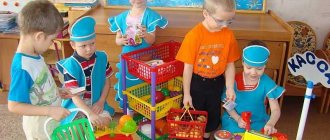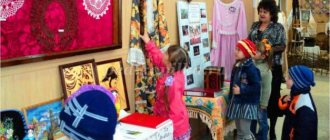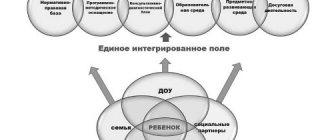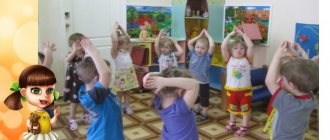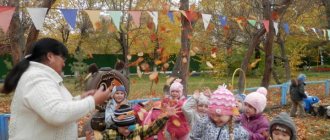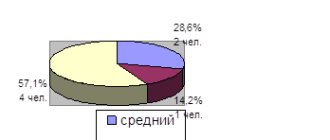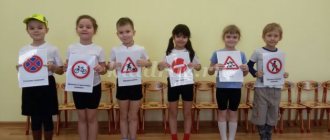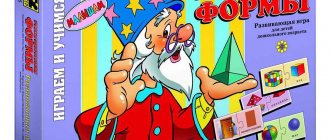Musical games for preschoolers
Musical games for preschoolers: “Let’s get to know each other and be friends!”
Author: Kurkina Irina Sergeevna, music director of MBDOU-kindergarten No. 106, Yekaterinburg
The material is addressed to teachers of preschool educational institutions (music directors, educators), is a selection and description of musical games that contribute to the acquaintance of children, their adaptation in the team, the formation of friendly and friendly relations. The games are offered in several versions, according to the age categories of children (junior and senior preschool age). Goals, tasks, necessary attributes are separately indicated for each game, and the author's sheet music is included. Goal: to ensure the successful socialization of each child in the children's team. Objectives: - create conditions for children to get to know each other and communicate confidentially with others; - developing children’s interest in each other, helping them remember the names and appearances of other children (in a new team); - create a comfortable psychological atmosphere, an environment in which children easily come into contact with each other; — develop children’s communication skills; - cultivate friendly attitudes towards other children, a positive attitude towards friendship; - promote the development of children's musicality.
"Clear sun"
(folk songs, music by I. Kurkina) Musical game for children of the younger group The purpose of the game: to involve children in joint musical activities, to promote children’s communication with each other during the adaptation period. Objectives: - evoke a positive emotional response from the child; - create a situation for the formation of trusting relationships, contact with all participants in the game; - develop the ability to perform basic actions that reflect the content of the text; - develop the ability to be a “leader” in the game, choose another “leader” instead of yourself, and agree with the choice. Attributes for the game: Option 1: screen house, “Sun” hat (the child presenter is the “sun” himself). Option 2: a scarf approximately 35x35 cm (chiffon scarf) in blue or blue (“sky”), a toy “Sun” (the child leader manipulates the toy). Contents: Children sit on chairs with their hands palmed on their knees. The leading child - “sun” - is opposite them behind a screen (Var.1), or (Var.2) the “sun” is hiding behind a scarf - “sky”. “Sky” can be held by two child helpers or an adult. The game is played with instrumental musical accompaniment (or simply singing).
From the beginning of the song, the playing children “call the sun”:
“Clear sun!
Look out the window!” . During the musical passage, the “sun” peeks out from behind a screen or appears from behind a handkerchief.
Then, continuing the song, the children invite the “sunshine” to come out to them and turn their hands over with open palms up:
“Come out, sunshine quickly.”
Caress and warm! For the musical role-play, the “sun” approaches all the children in turn (in any order), stroking their palms. When the music ends, he chooses a new “sun” in his place (hands over a toy or a hat).
"Hello, dear friend"
(lyrics and music by I. Kurkina) Musical game for children of the middle group The purpose of the game: after moving in all directions, be able to quickly find a couple, greet your partner kindly, using expressive singing and dance movements for this. Objectives: - evoke a positive emotional response; - develop the ability to greet others using a gentle, expressive intonation of voice, a smile, a friendly, open look, and posture; — to train children in the ability to quickly find a mate after moving in all directions; - to train children in the ability to move rhythmically in accordance with the nature of the music - with a calm or vigorous step, easy running, skipping (jumping), stopping at a sound signal; - improve the ability to consistently perform elementary dance movements in a pair - swinging clasped hands left and right, spinning (clasped hands are lowered down); - promote the formation of friendly relations between children. Contents: After the adult’s introductory words, “Somehow the legs set off to travel along the path...” the children move scattered according to the nature of the music (with a calm rhythmic step).
On the 2nd phrase, when repeating the musical theme, the adult indicates the moment the children stop moving and organize them into pairs: “We met a friend’s legs on the path...”.
The next part of the music is the children singing a song to each other, while simultaneously performing movements in pairs: Hello, hello, Hello, dear friend!
(They look at each other, rhythmically swing their clasped hands left and right).
Hello hello!
Look around! (They spin around in pairs, clasped hands are lowered down.)
Hello, hello, smile at me, and become stronger friends with me!
(Stroking each other's eyes, spread their arms wide to the sides, smile, hug each other). Next, the game will be repeated in the words of the adult: “The legs set off to travel along the path again...”. The musical theme is played, but with a different character of performance (the texture of the accompaniment, dynamics, tempo changes). The children again move in all directions, changing the nature of their movement according to the music (brisk step, march, easy run, jumping).
"Hide and Seek Walk"
(music by T. Lomova, game model by I. Kurkina) Musical game for children of primary preschool age Purpose of the game: remember the composition of the children in the group, name the “hidden” child. Objectives: - to help remember the names and appearances of other children; - learn to use affectionate forms of names; - develop the ability to move to music in accordance with its character (calm step), stop when the music ends. - develop attention and memory. Attributes for the game: - a small scarf or blanket Contents: Children move randomly to the music, with a calm step. As soon as the music ends, everyone sits down and closes their eyes. An adult covers one of the children with a scarf (blanket) and invites all the other children to open their eyes, stand up and name who is hidden under the scarf. When the children guess who is hidden, the adult offers to call him by name in an affectionate manner. The “hidden” child then responds (“Here I am!”), gets up, takes off the scarf, and the game repeats from the beginning.
*Note: any other small musical piece of a calm nature can be used for the game.
"This is how we meet friends"
(Belarusian (Russian) folk melody “On a Green Meadow”, lyrics by I. Kurkina) Musical game for children of senior preschool age Purpose of the game: to greet your partner kindly, using expressive gestures and singing.
Objectives: - evoke a positive emotional response from the child; - create a situation for the formation of trusting relationships, contact with all participants in the game; — to train children in the ability to expressively, rhythmically and consistently perform gesture movements in pairs, gradually accelerating the pace of their execution in accordance with the music; — to promote the development of the ability to perform dance spatial rearrangements: counter movement in two ranks, passing a “comb” (dance pattern “combing”); - promote the development of coordination of movements, skills of orientation relative to oneself (right-left). Contents: At the beginning of the game, children stand in two lines. Everyone knows their “partner” (this is the child standing opposite). The ranks are located at a distance of 4–5 steps from the center line. Children sing the game song and at the same time perform the appropriate movements: We will wave our hand - like this!
(we wave to our partner with our right hand)
We will wave with the other - like this!
(we wave to our partner with our left hand)
Let’s approach each other - like this!
(four steps towards your partner - both ranks converge along the center line))
And let’s hug each other - like that!
(we hug our partner)
Let’s smile at each other - like this!
(we smile and look at our partner’s smile)
Let’s give a hand to a friend - like this!
(to the word “here” everyone puts their right hand palm up, to the word “so” they put their left hand on the partner’s right palm)
And let’s jump up together - like this!
(they jump up at the same time - 1 time for the word “so”)
Together we have more fun - like this!
(to the words “together we have more fun,” we swing our clasped hands twice, crossing them and spreading them apart; to the word “here,” clap with a partner with the palm of the right hand; to the word “so,” with the right hand, each performs the gesture “Wow!”) Next, the children pass with their left shoulder past the partner to the opposite side (exchange lines-ranks as in the dance pattern “comb”, “comb”). After completing 4 steps, they turn around again to face their partner. The game is repeated, but at a faster pace (musical accompaniment and singing speed up each time).
"Wolf and Hares"
(music by I. Kurkina, folk lyrics) Musical game for children of senior preschool age Purpose of the game: remember the composition of the children in the group, name the “hidden” children. Objectives: - to help remember the names and appearances of other children; - develop creative abilities, the ability to move expressively, convey through movement the image of animals (wolf, hares); - develop attention and memory; — enrich the experience of children’s interaction in a role-playing game. Attributes for the game: - mask-hat “wolf” - headbands “bunny ears” (according to the number of children playing) - screen Contents: The game is played with song accompaniment and the participation of a “leader” - this can be an adult or a child. The leader, “Wolf,” is selected by any counting rhyme or by agreement. All other children playing are “hares”. They move in scattered jumps in the center of the hall (the so-called “clearing”), and at this time the “wolf” walks around, carefully looking at the “hares”, memorizing them. After the “hares” finish singing the song, they stop (“freeze”) in their places. The “wolf”, having looked again and remembered the players, turns away and closes his eyes. The “leader” of the game selects one or 2-3 “hares” with gestures, which leave “the clearing” (hide behind the screen). Then, at the command of the “leader,” the remaining “hares” say in chorus to the “wolf”: “One, two, three! Look!" After this, the “Wolf” must name the “hares” that are no longer in the “clearing” by name. If he names those who are absent correctly, he can then “catch” them. The remaining “hares” remain standing in their places and do not move, but they can “disturb” the wolf by holding hands and thereby block his path in some places. From among the captured “hares,” the “wolf” chooses a new leader in his place. (If the “wolf” could not name the “hidden” hares, then he does not catch anyone, and when the game is repeated, he remains the leader again).
We recommend watching:
Musical didactic game for older preschoolers The influence of musical and didactic games on the development of younger preschoolers Musical and creative game for older preschoolers “Silver Snowflake” First musical games with a baby
Similar articles:
Games, songs, exercises for younger preschoolers “Igralochka”
Games for the development of imaginative thinking in children 5-8 years old
Games for the development of musical memory in children 4-8 years old
Games to develop a sense of rhythm in children 4-6 years old
Introducing a child to music
If you want to create a developmental environment for your son or daughter, start with yourself. The child needs to demonstrate good taste in music and show that music is not just songs from cartoons.
Listen to classics from birth
Introduce your baby to the classics immediately after birth. Pleasant melodies are soothing, and listening to classical music helps to develop the right musical taste in the future.
Babies can play lullabies from children's classics:
- P.I. Tchaikovsky – “Birds”, “Dream”;
- V.A. Mozart - “Sleep, my joy, sleep”;
- F.P. Schubert - “Lullaby”;
- J. Brahms - “Lullaby”;
- R. Schumann - “Dreams”;
- E. Grieg - “Poetic Picture”.
A preschooler is ready to listen to works that have a plot:
- P.I. Tchaikovsky - cycle “The Seasons”, fantasy overture “Romeo and Juliet” (love theme), collection “Children’s Album” (“The Doll’s Disease”, “Baba Yaga”, “Song of the Lark”, etc.), excerpts from “ The Nutcracker" ("Dance of the Sugar Plum Fairy", "Exit of the Mouse King");
- Jules Massenet - “Elegy” (can be performed by F.I. Chaliapin);
- Edvard Grieg - "The Dance of Anitra"
Listen to music together, ask questions about what emotions the child experiences and what he imagines when listening to the composition. Explain to your child that a story can be told not only with words, but also with the help of melody.
Play music from different genres
Listen to different music at home. Perhaps the child will not appreciate your preferences - turn on music of different styles. Let it not be every day, but according to the mood, in a good mood. Remember that hearing is a very delicate mechanism and needs to be protected, so don’t make it too loud.
Experiment, watch the reaction: what the baby reacts to with interest, what music he dances to. Don't force your tastes on your child. Your goal is to develop an ear for music, not to discourage listening to music in general.
Introduction to musical instruments
It is advisable to approach the choice of the first toy instruments responsibly if you want to teach your baby to listen and make beautiful sounds, and not randomly strum. Toys must be of high quality.
For the first acquaintance, a xylophone or metallophone, an electronic piano, a drum, and maracas are suitable. After 3 years - a children's guitar, drum set, organ organ. These tools are great for developing coordination and fine motor skills.
Closer to 5 years, when the child learns to behave in a cultural place and withstand long events, you can go with him to the Philharmonic for classical music concerts, or to the ballet, or to the children's opera. Live sound is useful for the development of musical hearing - the child not only hears music, but also perceives it visually.
There is hearing, but what about voice?
Along with an ear for music, it is necessary to develop a child’s vocal skills from childhood. A well-trained voice and breathing are important not only for beautiful singing, but also for expressive speech. Remember how poems read by some classmates caused yawns in literature lessons. Even if your child does not become a singer, beautiful speech will not hurt him.
Some children are better at music, others at singing, but both of these talents can be successfully trained. You can develop your breathing and voice at home with simple exercises:
- Breathing exercises . Breathing training is never superfluous, especially for children with speech therapy problems. Breathing is the energy that powers speech. Blow with your child on a feather, weather vane, candle, blow confetti from your palm, push boats in a bowl of water. Breathing should be uniform, slow, coming from the depths of the body.
- Reading aloud . If the child knows poems, let him recite them with expression. Unobtrusively correct your baby if he is unexpressive.
- Chant sounds and words. This means you need to draw out the sounds “I”, “E”, A”, “O”, “U” on one exhalation. This is also useful as articulation gymnastics. Sing words that can be sung.
- Allow your child to scream. Not always and not everywhere, of course. Where it won't disturb others. Let the baby listen to his voice and feel its power. Sometimes even adults don’t know that they have a strong voice because they have never tried to sing “to the fullest.”
These exercises are enough for home training, but they can teach a child to sing professionally in a music studio, where a teacher who knows how to find an individual approach to his charges works with children.
Musical education is not given as much time as we would like, and the talent inherent in nature may fade away. Not all children retain an interest in music at school age. Many go to music school only at the insistence of their parents and do not enjoy learning. Maybe homework from birth will help the child to love his abilities, and in the future - to realize the full value of his natural gift.
